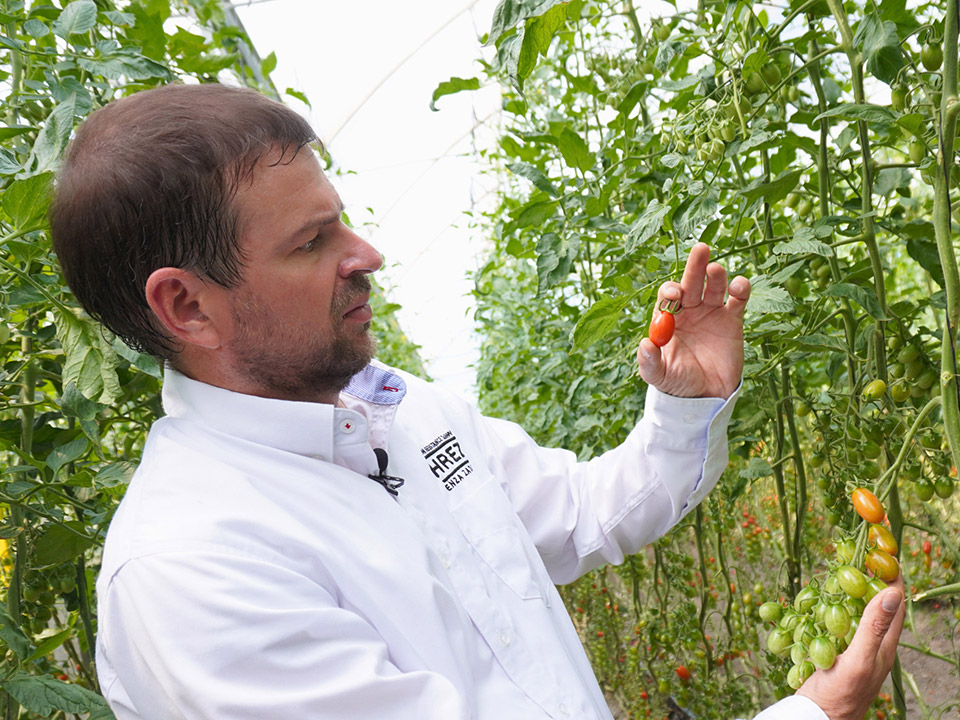
Information

The Tobamoviruses are one of the most studied plant viruses. The first tobamovirus was discovered on tobacco plants in the form of a mosaic discolouration. The combination of 'tobacco' and 'mosaic' gives this virus its name: tobacco mosaic virus. Tobamovirus is a genus of positive-stranded RNA viruses in the family Virgaviridae. Many plants, including pepper, cucumber and tomato, are susceptible to these viruses. The virus can be recognized by the following symptoms: the discolouration or deformation of the leaves and fruits.
ToBRFV is a plant virus that belongs to the Tobamoviruses. These viruses occur in tomato crops and are spread not only by people and tools, but also by bumblebees, birds and infected fruits. When it appeared, ToBRFV broke the Tm-22 gene that protected the industry for over 50 years from other Tobamoviruses. As a result, all tomato varieties available in the market at the time, are susceptible to ToBRFV.
Most tomato varieties have high resistance to the tobamoviruses ToMV and TMV. For ToBRFV, which breaks this long-used resistance, no resistance had been developed until recently.
We realized how serious this matter was for the tomato industry, dedicated large resources in search for a new source of resistance. Fortunately, the team of researchers rapidly identified a new source of resistance in their gene bank.
Martijn van Stee, Crop Breeding Manager Tomato, gives an insight into the process to create high-resistant varieties: “Since we discovered the ToBRFV high resistance gene we worked hard on introducing it in our elite parent lines. Today, we already developed high-quality varieties with ToBRFV high resistance.” Want to read more detailed information? More about ToBRFV

Several strains of tomato mosaic virus (ToMV) are known. This Tobamovirus species can cause a lot of damage, including Leaf mosaic and fruit discolouration as some of the most common symptoms. Almost all commercial tomato varieties are resistant to ToMV. As a result, symptoms are rarely seen.
ToMV is spread by mechanical transfer. The virus can, for example, be transmitted by harvesting and pruning.
The pepper mosaic virus, also called Pepper Mild Mottle Virus (PMMoV) is a worldwide found Tobamovirus that infects wild, commercial and ornamental peppers. Symptoms of the disease vary, but on young leaves gives a vague mosaic image of dark and light green spots. These symptoms are usually best observed at the base of the leaf. Infected pepper fruits may show symptoms of blistering, deformity and necrosis. The virus is easily transmitted through contact or seed transplantation. Control options include cleaning and removing sources of infection such as old crops, and the use of resistant varieties.
Tobacco Mosaic Virus (TMV) is a well-known Tobamovirus. The virus is originally found in tobacco, but also in tomato and pepper cultivation. This is a very stable virus and difficult to fight. It inhibits plant growth and causes loss of production. As these viruses are difficult to fight, it is important to take the necessary sanitary measures in order to prevent infection.
Contamination with TMV causes a pale green discolouration between the veins, first on young leaves and later, on older leaves. Then, on the leaves, a light and dark spotted pattern is formed called a mosaic pattern. Later, the skin may wrinkle or curl. You see this especially with older leaves at the bottom of the plant. Growth is also uneven. Tobacco mosaic virus eventually causes growth inhibition through e.g. less photosynthesis.
Because it is a very stable virus, it can survive in tobacco products for a long time. The risk of TMV can be limited by strict hygiene measures and the use of resistant varieties.
In addition, it is important to stay informed of the latest virus and resistance developments.
Data information and illustration provided by Enza Zaden on this webpage are provided to assist professional growers and users and, are based on Enza Zaden’s assessment of its test results and practical experience however without any guarantee, representation or warranty regarding accuracy thereof or purpose and/or performance of the HREZ variety in practice. Environmental conditions must be taken into account. Under no circumstances shall Enza Zaden be liable to the professional grower or user for results deviating from that information.